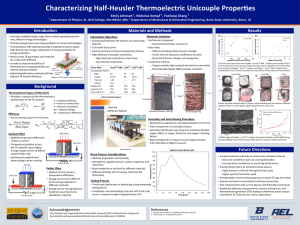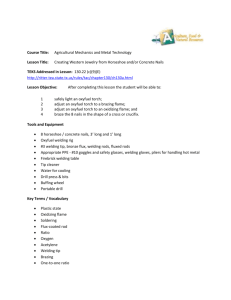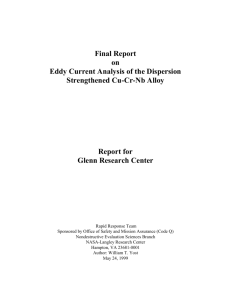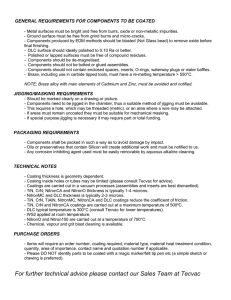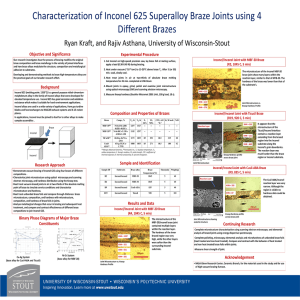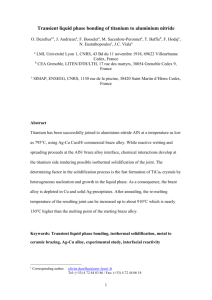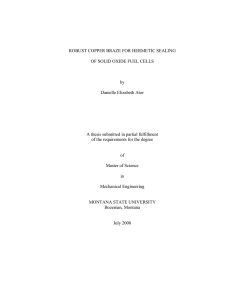Peter K. Sokolowski, Thomas F. Murphy, and Bruce A. Lindsley
advertisement
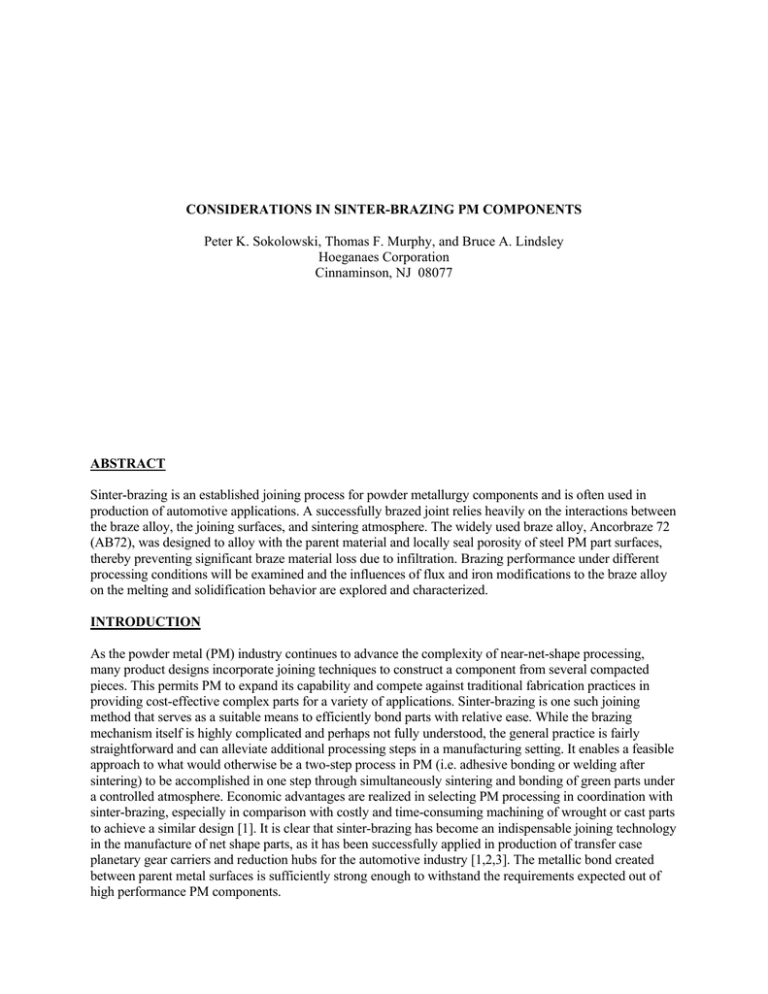
CONSIDERATIONS IN SINTER-BRAZING PM COMPONENTS Peter K. Sokolowski, Thomas F. Murphy, and Bruce A. Lindsley Hoeganaes Corporation Cinnaminson, NJ 08077 ABSTRACT Sinter-brazing is an established joining process for powder metallurgy components and is often used in production of automotive applications. A successfully brazed joint relies heavily on the interactions between the braze alloy, the joining surfaces, and sintering atmosphere. The widely used braze alloy, Ancorbraze 72 (AB72), was designed to alloy with the parent material and locally seal porosity of steel PM part surfaces, thereby preventing significant braze material loss due to infiltration. Brazing performance under different processing conditions will be examined and the influences of flux and iron modifications to the braze alloy on the melting and solidification behavior are explored and characterized. INTRODUCTION As the powder metal (PM) industry continues to advance the complexity of near-net-shape processing, many product designs incorporate joining techniques to construct a component from several compacted pieces. This permits PM to expand its capability and compete against traditional fabrication practices in providing cost-effective complex parts for a variety of applications. Sinter-brazing is one such joining method that serves as a suitable means to efficiently bond parts with relative ease. While the brazing mechanism itself is highly complicated and perhaps not fully understood, the general practice is fairly straightforward and can alleviate additional processing steps in a manufacturing setting. It enables a feasible approach to what would otherwise be a two-step process in PM (i.e. adhesive bonding or welding after sintering) to be accomplished in one step through simultaneously sintering and bonding of green parts under a controlled atmosphere. Economic advantages are realized in selecting PM processing in coordination with sinter-brazing, especially in comparison with costly and time-consuming machining of wrought or cast parts to achieve a similar design [1]. It is clear that sinter-brazing has become an indispensable joining technology in the manufacture of net shape parts, as it has been successfully applied in production of transfer case planetary gear carriers and reduction hubs for the automotive industry [1,2,3]. The metallic bond created between parent metal surfaces is sufficiently strong enough to withstand the requirements expected out of high performance PM components. As a distinguishing attribute of PM processing, interconnected porosity in parts is known to generate significant capillary forces. While capillary action is responsible, and essential, for pulling molten braze into the designed joint gap, the capillary forces from pores are generally too great and will quickly pull braze away from the joint interface. The pore network acts as a conduit for drawing filler metal into the bulk of the part, potentially resulting in a joint deficient of filler metal. For this reason, porosity is always a challenge during sinter-brazing. One option to alleviate the issue is to Cu infiltrate before brazing, thereby completely filling the porous body. This, however, is an inefficient and likely cost prohibitive processing method. Alternatively, pressing to densities >7.2 g/cm3 can also prevent infiltration [4]. Infiltration to short distances may be advantageous, however, in promoting increased joint strength and at higher densities the closing of surface pores may completely inhibit this from occurring. In doing so, the joint strength could be less than expected. Therefore, PM brazing requires a specific filler alloy capable of partially infiltrating while largely remaining within the intended gap to create a strong bond. A well-established brazing alloy, Ancorbraze 72, was specifically designed for the PM industry to accomplish this, solidifying after infiltrating short distances. This prevents excessive loss of braze material into the bulk of the part, while leaving behind enough filler metal to create a strong metallic bond between parent surfaces. The mechanism occurs as the liquidus temperature of the molten braze rises as the braze material solutions with the iron matrix. As the liquidus temperature increases, surface tension rises and flowability is reduced making it difficult for the braze alloy to penetrate further, eventually solidifying at or near sintering temperatures. Conceptually, these are the steps through which brazing works to join PM parts, nonetheless, it is not always a smooth and wellcontrolled process as many external parameters influence its behavior. While PM sinter-brazing has been highly successful in application, there are seemingly random occurrences where excessive infiltration takes place as the braze material fails to alloy immediately with the iron upon melting to close off porosity adjacent to the part surfaces. An example of an acceptable braze joint can be seen in Figure 1 (a), displaying a sufficient amount of filler metal within the gap and minimal infiltration into the parent surfaces, likely providing adequate joint strength. a. b. Figure 1: (a) Example of a good braze joint showing minimal infiltration of the braze alloy (light phase) into the parent material, (b) example of a poorly brazed joint with excessive braze infiltration, resulting in a continuous void throughout the joint area; parent materials are FC-0208 at 7.0 g/cm3 and images were etched using 2 v/o Nital - 4 w/o Picral In contrast, Figure 1 (b) illustrates excessive infiltration into both sides of the joint, the lighter phase being rich in braze alloy. As a result of too much infiltration, there remains an insufficient amount of braze material to fill the gap. This phenomenon is not always well understood and significant effort is put into addressing the issue when it arises in a manufacturing setting. It is known that some part manufacturers utilize small additions of iron powder to the braze premix to prevent surface erosion, common with liquid phase processing, and potentially to counteract excessive infiltration. Previous research which supports this approach has shown that adding iron powder to a braze premix will influence the onset of solidification temperature and perhaps have an impact on the degree of infiltration [5,6]. There are many established guidelines to follow in practicing the art of brazing [1,6,7]. One critical factor is the atmosphere composition and ensuring it is controlled at each step in the sintering cycle. While the part is within the preheat zone it is essential to be slightly oxidizing to promote effective delubrication without sooting. Contaminants that remain on the surface going into the high heat zone can negatively influence wetting and impede braze from flowing through a gap. If the atmosphere is too oxidizing in the preheat zone, oxidation of the braze constituents can occur. In this event, the braze material may not be sufficiently reduced in the high heat zone or altered by the fluxing agent to allow adequate wetting and flow. A greenish tint on the surface of braze is an indication of excessive oxidation [1]. The atmosphere may need to be adjusted as furnace loading changes and the speed with which parts are sent through. Another factor during sintering involves the heating profile of the part, as uneven part temperatures can result in irregular braze flow as a result of higher temperatures drawing the braze material away from cooler areas. This can produce an unevenly brazed joint. In addition, slow heating rates may encourage lower melting constituents to separate out of the braze and quickly re-solidify upon alloying with iron, preventing the remaining braze from flowing into the gap [2]. Efficient wetting of the parent materials by the liquid braze is always key to a successful brazing operation. Surface oxides can inhibit the spreading of the braze alloy over surfaces and must be removed before the braze will wick through the joint [8]. For that reason, it is critical to incorporate a flux to dissolve surface oxides on both braze and parent materials, promoting wetting and spreading of the braze as surface tension is reduced. In using a flux, a glassy residue containing metal oxides (Mn or Si oxides typically) is left behind where the braze pellet was placed. The residue is generally adherent, yet there are instances where it has been known to spall off during service if not removed. Common practices, therefore, incorporate blind holes or enclosed cavities into the part design to retain the residue and prevent it from interfering with moving parts during service. If an open hole design is used in applying braze, methods to remove the glasslike flux residue including washing, chemical attack, or abrasive actions to loosen the residue may be recommended. Nonetheless, addition of flux to braze is necessary in sinter-brazing unless the process is performed in a vacuum chamber. Historically, sinter-brazing was largely performed in furnaces using endothermic gas and Ancorbraze 72, as the primary PM brazing alloy, was designed for use in this atmosphere. Endo gas is typically composed of about 20-23 v/o CO, 30-40 v/o H2, 40-47 v/o N2, 1 v/o water vapor, and 0.5 v/o CO2 with the ability to adjust the dewpoint and carbon potential depending on desired effects. Over the years, numerous sintering furnaces have been switched over to dry, lean atmospheres, 90 v/o N2 – 10 v/o H2, for economic advantages. The challenge has been to provide consistent brazing results as the atmosphere composition has changed, leading to unpredictable brazing behavior. In an effort to improve understanding of the alloy and influential processing parameters affecting brazing behavior, the following study has been undertaken to qualitatively evaluate braze melting and solidification behavior, and how adding iron to the premix alters its interactions in a lean sintering atmosphere. METHOD The braze alloy used in this study, Ancorbraze 72, was produced by water atomization having a nominal composition of 41 w/o Ni, 40 w/o Cu, 15 w/o Mn, 1.8 w/o Si, and 1.5 w/o B. A commercially available – 425m/+75m particle size distribution was used in making compacted pellets. These pellets, weighing 0.85g each, were compacted at 20 MPa from premixed compositions with 0.75 w/o Acrawax as the lubricant. Wetting behavior of braze was determined by placing a braze pellet on top of a 1-inch diameter base compact and sintering in an Abbott high-temperature continuous belt furnace at 1120 °C (2050 °F). The base compacts, pressed to 7.0 g/cm3, were made from combinations of commercially available iron powder, Ancorsteel 1000B, copper powder type ACuPowder 8081, and Asbury type 3203H graphite. Parameters that were evaluated in all possible combinations are listed in Table 1. In addition, one set of base compacts was pre-sintered in 90 v/o N2 -10 v/o H2 before sending through a second time with braze pellets to determine any influence of starting with a green or sintered surface. The remnants of the braze pellet were visually examined after sintering to observe effects of varying the listed parameters. Table 1 Braze Wetting Study Parameters Compact Compositions Braze Additions Atmospheres F-0000 No flux 100% H2 F-0005 3 w/o flux 90%N2 / 10%H2 F-0008 5 w/o flux 90%N2 / 10%H2+ 0.5%CH4 FC-0200 3 w/o flux+10 w/o Fe 90%N2 / 10%H2+ 0.5%CO FC-0205 FC-0208 3 w/o flux+0.5 w/o graphite As a result of observations from the wetting behavior study, the effect of graphite content in the base compacts was further investigated. Iron-based mixes were made with 2 w/o Cu and three different levels of graphite at 0.3, 0.6, or 0.8 w/o. Brazed joints were constructed by stacking rectangular green test bars with dimensions of 1.25 x 0.25 x 0.5 inch from these mixes, compacted to 7.0 g/cm3. The top bar had a hole drilled through the middle for placement of a braze pellet. The samples were sinter-brazed at 1120 ºC in 90 v/o N2 -10 v/o H2 atmosphere. To create the spacing between parts, the top bar was compacted with chamfered edges into one face, providing a gap of 0.076-0.127mm (0.003- 0.005inch) between the upper and lower bar. Samples were sectioned perpendicular to the joint and standard metallographic practices were followed in mounting and polishing for optical imaging. In addition, automated image analysis was used to measure porosity distribution across the sinter-brazed joints as a function of distance from the brazed joint centerline. Additionally, braze melting and solidification behavior and its interaction with iron was evaluated using differential thermal analysis (DTA). Representative samples were measured in alumina crucibles using a simultaneous TG-DTA STA 449 Jupiter under flowing nitrogen atmosphere at 40mL/min. The temperature profile included ramping from 25 ºC to 1130 ºC at 20 ºC/min and holding for 5 minutes at temperature before cooling down to 600 ºC at 20 ºC/min. Additions of fine iron were blended with the braze premix to study the influence of iron going into solution in the braze alloy. In addition, an FC-0208 premix with braze layered between was examined in an effort to simulate sinter-brazing with a typical component composition in the DTA. RESULTS AND DISCUSSION Part 1 – Wetting Study Observations: In Figure 2, sintered examples from the wetting study are presented. Not all observations could be presented herein, yet general trends are illustrated using an FC0208 base compact composition in a 90 v/o N2 – 10 v/o H2 atmosphere unless otherwise labeled. In the first row, increasing the amount of flux appeared to have negligible influence on surface spreading or infiltration, where infiltration was excessive in each case. With the addition of 10 w/o fine Fe to the braze, an increased amount of braze remained on top, however appeared to have little effect on spreading. In the second row, different atmospheres were used in conjunction with 3 w/o flux addition. In each case, significant infiltration was prevalent. Additions of CH4 and CO appeared to have more residue remaining on the surface in comparison to 100% H2 results. In the bottom row, the composition of the base compact was modified. With no graphite addition to the base compact, the braze alloy showed significant surface spreading and little infiltration. With no Cu addition and increased amount of graphite, there was increased infiltration into the base compact. Alternatively, when the base compacts were pre-sintered, the majority of the braze material remained on the surface in all conditions tested. 3w/o flux 5w/o flux 3w/o flux+10w/o Fe 0.5% CH4 0.5% CO 100%H2 FC-0200 F-0008 FC-0208 Pre-sintered Figure 2: Examples of the wetting study using 1-inch diameter compacts with melted braze / residue remaining on top; FC-0208 compact compositions (unless otherwise labeled) with the significant parameter labeled and hence illustrated in corresponding photo Several key conclusions can be drawn from this study: Graphite in the base material has a strong influence on braze wetting behavior. Additions of graphite in the compact lead to increased infiltration and, therefore, reduced material available for spreading on the surface. Compacts with no added graphite exhibited the greatest amount of spreading on the surface. While reduced graphite shows to reduce infiltration, this is not a feasible option in manufacturing PM components, as graphite is required to improve strength and achieve desired properties. Pre-sintering of the compacts had significant impact on preventing infiltration, however, this approach is likely not economically practical in a manufacturing setting. Additions of fine iron to the braze premix appeared to result in a decreased amount of infiltration into the compact and further investigation explores this interaction. Additions of flux are necessary to dissolve surface oxides and promote surface wetting in all tested conditions; increasing to 5 w/o flux did not appear to improve upon results seen at flux levels of 3 w/o with respect to how the braze flowed on the surface. Any benefit in increasing flux content may not be apparent under laboratory conditions and may be further influenced by a fully loaded production furnace. Copper powder in the base material has no effect on wetting of the surface in samples that were in the green state prior to sintering. Pre-sintering of the compacts resulted in minor improvement in surface spreading of the braze going from 0 – 2 w/o copper. This behavior suggests that Cu in solution with the iron surfaces reduces the wetting angle of braze in contact with iron, allowing it to alloy more successfully and thereby preventing infiltration and encouraging spreading instead. Additions of graphite to the braze premix had a negative influence, preventing the braze particles from coalescing and wetting the surface of the compact at all. This suggests that any residue or sooting created during the preheat zone of a furnace can greatly impede braze from wetting a surface and flowing, regardless of flux content. Injecting small amounts, 0.5 v/o, of CO or CH4 into the atmosphere did not appear to improve the wetting behavior or prevent infiltration in this study. Results may be different, however, in a fully loaded production furnace. Part 2 – Supporting Evidence: Infiltration of braze into the base compact was a common result regardless of changing parameters in most cases. One interesting observation, which continued to be a trend throughout the testing, was the increased spreading of braze material on the surface as a result of reduced graphite content, as opposed to infiltration. To further investigate the influence of graphite content in the base material, braze joints were assembled using different levels of graphite admixed in the base bars. Effect of Graphite As shown in Figure 3, sinter-brazed bars using a FC-020X base material (where x is carbon content) pressed to 7.0g/cm3 are compared. In (a), the sintered carbon content is 0.28 w/o and the brazed joint is clearly defined. Note there is minimal infiltration into the part as the pore network was closed off early in the process. Looking at (b), where there is 0.55 w/o sintered carbon in the base material, the alloy flowed further into the part before sealing off porosity. In the sample containing 0.72 w/o sintered carbon, as seen in photo (c), the interface between the part surface and the braze joint is more obscure as increased amounts of iron are dissolved from the original surface and braze material infiltrates even further into the adjoined parts. While braze appears to penetrate further into the open pore network at levels of 0.72 w/o sintered carbon, this does not imply excessive infiltration has occurred, as the joint remains completely filled with braze material. It is noteworthy that the morphology of the microstructure within the joint changes as more of the braze alloy is allowed to infiltrate the parts. To date, tests have not been performed to determine the effect on joint strength as a result of this microstructural transformation. It is, however, believed that some infiltration by the braze alloy into the base materials is desired to promote a more uniform metallic bond as is shown in Figure 3 (c). a b c Figure 3: Sinter-brazed joints comparing the effect of different levels of carbon in base material with a composition FC-020X, where x = 0.3, 0.6, and 0.8 admixed graphite; (a) PM steel at 0.28 w/o sintered carbon, (b) 0.55 w/o sintered carbon, and (c) 0.72 w/o sintered carbon; parts were compacted to 7.0 g/cm3; light optical as-polished photos To support the visual observations on increased infiltration, the samples from Figure 3 were evaluated using image analysis to determine percent porosity as a function of distance from an estimated centerline of the brazed joint. The results of these measurements are shown in Figure 4. Given the average starting porosity level of the base parts is around 11%, the level of porosity should increase to that value at distances far from the brazing action. For the parts alloyed with 0.28 w/o sintered carbon, the porosity level quickly raises to that of the base part within 300m from the centerline indicating very little infiltration occurred. This measurement agrees well with the visual observation above. Comparatively, increasing the carbon level in the base parts leads to increased infiltration depths as indicated by the greater distance measured, 440 –500m from the centerline, before the nominal porosity level in the base bar is reached. These results indicate carbon content influences the development of the brazed joint, and potentially, the degree of infiltration. It is not fully understood however, how the carbon content specifically changes the wetting behavior, whether through aiding in reduction of surface oxides or manipulating the surface tension of the molten braze, preventing it from being in intimate contact with the iron surfaces. The indication that infiltration is greater with increased carbon content suggests the braze is unable to alloy with the iron initially and therefore continues to be pulled into the porous body. Figure 4: Percent porosity as a function of distance from the center of a brazed joint at three levels of sintered carbon in the base materials being joined Effect of Iron Another notable observation that came out of the wetting study was the influence of small additions of fine iron on the amount of braze retained on the surface of the compact. To further investigate the interaction between braze and iron, melting and solidification behavior was studied using DTA. As seen in Figure 5 (a), a typical DTA curve on heating of braze powder combined with 3 w/o flux shows the onset of melting around 935 °C and is completely liquid by 1060 °C. This result, though, does not take into account interactions with Fe or other constituents as experienced during sinter-brazing of PM components. To investigate the braze alloy’s interaction with PM steel surfaces, small additions of Fe powder were blended with the braze premix. In Figure 5 (b), it is evident that the onset of melting remains unchanged, regardless of premixed Fe content, as the initial braze alloy composition has not been altered at lower temperatures. As the alloy begins to melt in close proximity with Fe however, the liquid phase locally dissolves the Fe into solution with braze. This phenomenon extends the melting range to higher temperatures and is obvious with additions of 2 and 5 w/o Fe powder. At 20 w/o added Fe powder, the melting behavior is noticeably modified and the range appears to extend beyond the measurement shown during heating to 1130 °C. The downward slope of the curve, as it approaches 1130 °C, indicates melting is not complete as it reaches typical sintering temperatures. Although not shown, subsequent tests reveal that melting nears completion around 1160 °C with the addition of 20 w/o iron. a b c d Figure 5: Differential thermal analysis graphs of (a) braze + 3 w/o flux on heating to 1130 °C; (b) braze + Fe additions on heating to 1130 °C, all with 3 w/o flux, (c) braze on cooling, (d) braze + Fe additions on cooling Looking at Figure 5 (c), the solidification onset (initial exothermic peak on cooling) for braze only, begins around 955 °C and is complete by 830 °C during cooling from 1130 °C. This suggests the braze alloy would remain liquid for some time during sintering if it did not alloy with the Fe and likely lead to complete infiltration. Also, the presence of two separate peaks indicates two phases are present, under these conditions, upon solidification. The effect of adding Fe to the premix is rather evident during the cooling stage of the cycle and highlights the importance of the alloying mechanism which takes place as braze melts and dissolves the iron. The solidification onset temperature of the braze noticeably increases with the addition of Fe in solution. At 2 w/o premixed Fe, the solidification onset increases to 1010 °C and up to 1045 °C at 5 w/o Fe. The number of phases solidifying is altered as a result of the Fe in solution as the curves with Fe have an additional, although small, peak. Interestingly, at levels of 20 w/o Fe in solution, initial solidification of the major component of the alloy is near typical sintering temperatures. This suggests that as soon as the Fe content in solution with braze either approaches or is greater than 20 w/o, a significant liquid constituent of the braze alloy will be solidifying at sintering temperature. EDS analysis of braze joint microstructures, as seen in Figure 3 (a), indicate similar levels of Fe in solution throughout the joint area. These DTA results agree well with previous research on the influence of using Fe as an additive to modify the melting and solidification behavior of the braze alloy [5,6]. This also implies that there may be an opportunity to make small additions of Fe powder to braze premixes to potentially circumvent infiltration issues. By having Fe in close vicinity with the molten braze, less Fe will be required to dissolve from the parent materials to close off porosity. This has a two-fold effect, as it prevents surface erosion of the parts as a result of iron dissolution and advances the action of closing pores sooner in the process, preventing significant infiltration. The fact that braze is continuing to melt at sintering temperature, at levels of 20 w/o Fe in solution, suggests it may have considerable impact on its flowability. The flowability of braze greatly influences its ability to be pulled into interconnected porosity or readily wick throughout a gap. Naturally, the concept is designed in such a way that the braze alloy solidifies after infiltrating a short distance into a part as a result of increased Fe content in solution, preventing further loss of material from the joint area. Conversely, if braze is unable to alloy with the iron, it will be increasingly fluid at increased temperatures and more likely to infiltrate a porous body to greater distances, leaving an insufficient amount of material behind to create a strong joint. To further investigate the mechanisms involved with sinter-brazing of typical materials, an FC-0208 composition was studied in combination with braze using DTA. Seen in Figure 6 (a), a baseline curve for FC-0208 powder is given displaying the -to- phase transformation beginning around 850-860 °C and carbon is completely in solution by about 930 °C. The admixed copper melts at around 1083 °C and is entirely liquid by the time it reaches sintering temperature. Adding braze between two layers of an FC0208 mix within an alumina crucible illustrates the interaction between all components. While the -to- phase transformation appears to shift to higher temperatures when braze is present, it is not clear if this is just an effect of heating rate or if the braze has any influence on the transition. Also, the braze melting trend behaves similarly to the braze with 20 w/o added iron premix, as shown in Figure 5 (b). The braze may continue to melt as it reaches the Cu melting point, as the inflection point of the Cu is masked. a b Figure 6: (a) Differential thermal analysis of an FC-0208 material and FC-0208 with braze on heating to 1130 °C; (b) on cooling Looking at Figure 6 (b), the cooling curve of FC-0208 shows no invariant reaction taking place, suggesting the liquid Cu went into solution in Fe before the cooling stage began. With the addition of braze material to the mix, however, the initial onset of solidification for one phase begins around 1060 °C and finishes by 1000 °C. Compared with the results displayed in Figure 5 (d), this indicates the iron content for the initial onset of solidification is between 5 and 20 w/o Fe in solution. Further examination using additions of 10 w/o Fe powder (although not shown) suggest the Fe content to be closer to 10 w/o, as those results showed the onset to be about 1055 °C. CONCLUSION Sinter-brazing is an advantageous processing consideration in joining PM components that greatly expands the complexity PM manufacturing can provide. The brazing mechanism is a complex process influenced by numerous factors, each requiring special consideration to prevent brazing defects. It may be necessary to tailor the braze premix composition based on a part design and constraints, as well as intended sintering conditions if problems such as excessive infiltration arise during processing. Clearly, the ability of braze to sufficiently wet the surface of PM parts and wick between designed gaps relies heavily on sintering atmosphere and surface interactions between the solid, liquid, and gas species present. Small additions of iron powder to the braze premix influence the melting and solidification behavior of braze and may be useful in scenarios where infiltration continues to hinder the process. The addition of fine iron to the braze premix has been shown to increase the melting range and raise the onset of solidification significantly. The temperature ramp rate in a part during actual production runs will probably be slower than that tested in the DTA and additions of Fe need to be tested in a given application prior to actual application as results could vary. Also, the possibility to reduce graphite in the components being joined, as was shown to encourage surface spreading of the braze, is not practical, as most components require a certain amount of carbon in solution with iron to give sufficient strength and properties demanded from PM components. Another option identified is to pre-sinter the parts, which has been shown to result in reduced infiltration. This method, however, is not feasible from an economic standpoint and is not recommended. Regardless of the challenges that exist in sinter-brazing, it remains a cost-effective joining method to create strong bonds for complex PM parts when properly designed and controlled. Future work will focus on increasing understanding of brazing interactions and methods to improve its behavior in lean atmospheres. REFERENCES 1. I. Gabrielov, C. Wilson, and J. Hamill, “Sinter-Brazing Automotive Powertrain Components,” International Journal of Powder Metallurgy, Vol. 37, 7, 2001, pp 46-48. 2. M. Frank, “Advanced Sinterbrazed P/M Subassemblies in Torque Transfer Systems: Reduction Hubs and Carriers,” SAE, 2002. 3. M. Onoda, R. Kameda, and T. Koiso, “Application of Sinter-Brazing,” Metal Powder Report, November 1983, pp 632 – 634. 4. P. Beiss, “Finishing processes in powder metallurgy,” Powder Metallurgy, 1989, 32, 4, pp 277-284. 5. M. Stromgren and O. Andersson, “Brazing of P/M Parts by Sintering,” Technical Report - PM 89-6. 6. W. Knopp, Brazing Alloy Composition, United States Patent 3,717,442 Feb. 20, 1973. 7. R. Peaslee, “How to Identify Brazing Failures,” Advanced Materials & Processes, December 2003, p 35. 8. AWS Committee, Brazing Manual, 1963, American Welding Society, New York, NY.

